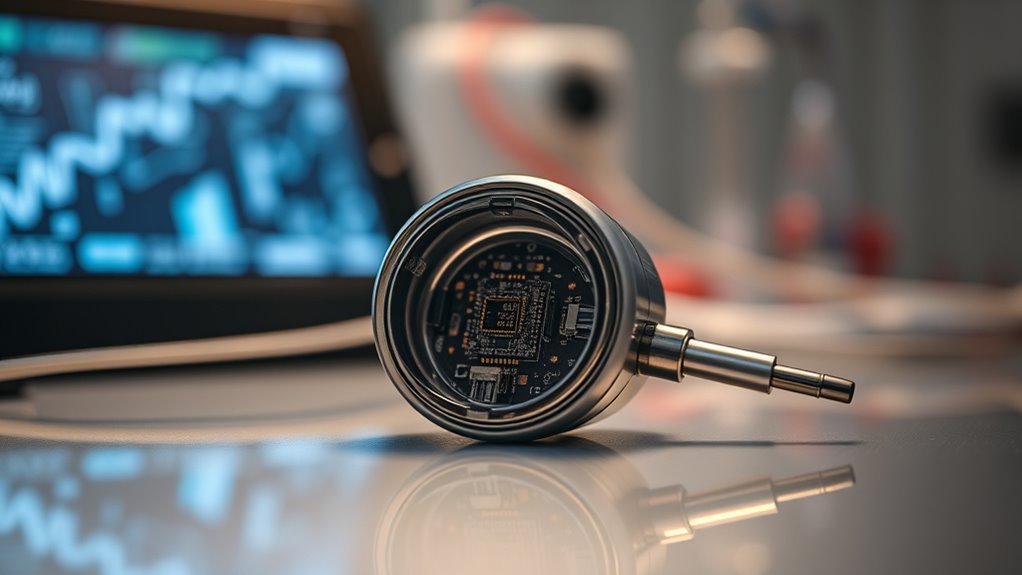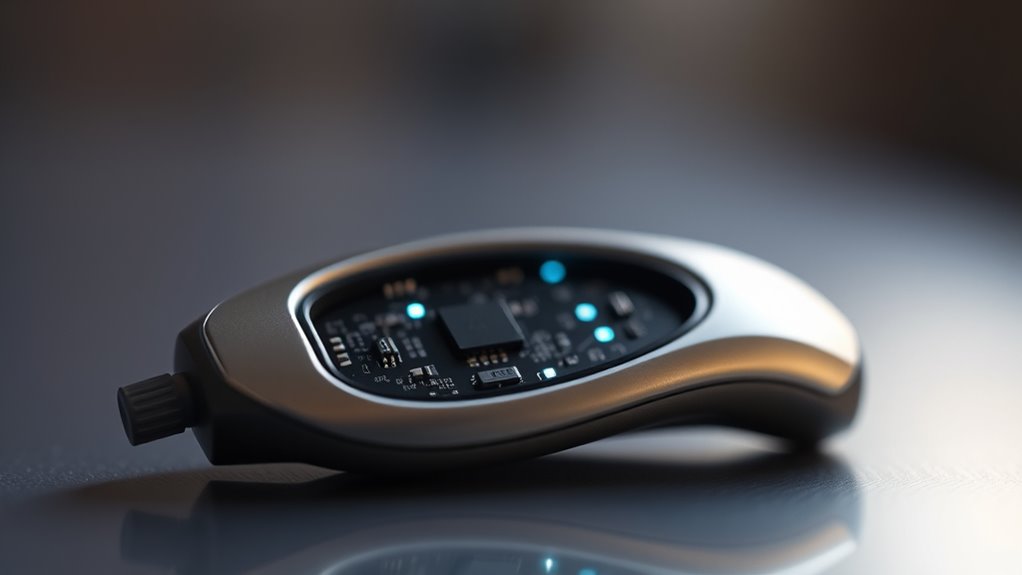Edge computing in cochlear implant processors is making devices smarter and more responsive by enabling real-time sound analysis and adaptive adjustments. You’ll experience clearer sound quality, better speech understanding in noisy environments, and longer battery life thanks to improved power efficiency. As technology evolves, expect more innovative features like smarter algorithms that learn your environment and preferences. Keep exploring to discover how these advancements will shape the future of hearing technology and your daily experience.
Key Takeaways
- Integration of smarter, adaptive algorithms for enhanced real-time sound processing and personalized hearing experiences.
- Increased use of hardware acceleration to improve privacy, security, and response speed on cochlear implant devices.
- Development of energy-efficient edge computing solutions to extend battery life and support continuous device operation.
- Enhanced environmental sensing and automatic adjustment capabilities for diverse acoustic settings.
- Ongoing innovations in hardware-software integration to create more responsive, natural auditory experiences for users.

Edge computing is transforming cochlear implant processors by enabling real-time sound processing directly on the device. This shift means you experience sound more naturally and instantly, without delays caused by transmitting data to external servers. With real-time processing, your cochlear implant can analyze and interpret auditory signals as they happen, providing clearer sound quality and better speech understanding in noisy environments. This advancement not only enhances your hearing experience but also makes the device more responsive to your surroundings, giving you a sense of greater control and confidence.
Edge computing enables real-time sound processing for cochlear implants, enhancing clarity, responsiveness, and user confidence.
One of the key benefits of integrating edge computing into cochlear implants is improved power efficiency. Traditional processing methods often require significant energy, leading to shorter battery life and frequent recharging. However, by moving processing tasks closer to the source—directly on the implant—you minimize the need to send large amounts of data elsewhere. This local processing reduces power consumption, allowing your device to run longer on a single charge. As a result, you’ll enjoy extended usage time without sacrificing performance, which is especially important for daily wear and mobility.
Moreover, edge computing enables your cochlear implant to adapt quickly to changing environments. Whether you’re in a bustling restaurant or a quiet office, the device can instantly analyze acoustic patterns and adjust settings for ideal hearing. This dynamic responsiveness relies heavily on real-time processing capabilities, which are now more efficient thanks to advancements in hardware and software optimized for power efficiency. The less energy your device consumes while performing these complex tasks, the more seamlessly it integrates into your daily routine.
Security and privacy also benefit from edge computing. Since sensitive audio data remains on the device rather than being transmitted to external servers, your personal information stays protected. This local data processing not only enhances your privacy but also reduces latency, ensuring your device responds swiftly to auditory changes. Additionally, innovations in hardware acceleration contribute to faster processing speeds and lower power use, further optimizing device performance. As technology progresses, future cochlear implants will likely incorporate even smarter algorithms that learn from your environment and preferences, all while maintaining low power consumption thanks to the efficiencies gained through edge computing.
Frequently Asked Questions
How Secure Is Data Stored and Processed Locally on Cochlear Implant Processors?
You might wonder how secure data stored and processed locally on cochlear implant processors is. Typically, manufacturers implement robust security protocols to protect your data privacy, including encryption and secure access controls. While no system is entirely invulnerable, these measures help safeguard your information from unauthorized access. It is crucial to stay informed about updates and best practices to guarantee your device remains as secure as possible.
What Are the Power Consumption Implications of Edge Computing in Implants?
Imagine your cochlear implant processor draining its battery in record time—that’s the power consumption challenge of edge computing. You need exceptional power efficiency to extend battery life, ensuring you’re not tethered by constant recharges. Edge computing demands more processing, which can markedly impact battery longevity. So, balancing advanced features with smart power management is vital to keep your implant working seamlessly without sacrificing usability or convenience.
Can Edge Computing Improve Real-Time Sound Localization Accuracy?
You can see that edge computing has the potential to improve sound localization by processing data closer to the source, reducing processing latency. This means you’ll experience more accurate spatial hearing in real time, as the system quickly interprets sound cues. By minimizing delays, edge computing enhances your ability to pinpoint where sounds originate, making your hearing experience more natural and responsive, especially in dynamic environments.
How Does Edge Computing Affect the Device’s Size and Portability?
You might wonder how edge computing impacts your device’s size and portability. It helps by enabling miniaturization, but also presents miniaturization challenges that designers must overcome. This technology offers greater design flexibility, allowing for smarter, more compact processors. As a result, your cochlear implant can become smaller and more portable without sacrificing performance, making it easier to wear comfortably and enjoy improved mobility and convenience.
What Are the Potential Risks of Increased Reliance on Local Processing?
Like a tightrope walker balancing carefully, you face risks with increased local processing. Relying heavily on it can heighten privacy concerns, as more data is stored and processed nearby. Additionally, processing latency might cause delays, affecting sound quality or response times. You need to weigh these risks against benefits, ensuring robust security measures and optimized processing speeds to keep your hearing experience safe and seamless.
Conclusion
So, it looks like edge computing in cochlear implants is finally stepping out of the lab and into your auditory everyday. Who knew that processing sounds right in your ear could be so revolutionary? Soon, you’ll be marveling at how your implant does all the heavy lifting, leaving you free to enjoy life’s symphony—without the tech taking center stage. Honestly, it’s about time your implant stopped being just a device and started acting like your personal sound wizard.











